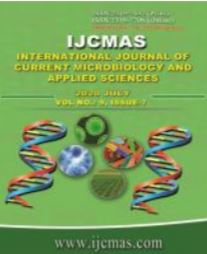


 National Academy of Agricultural Sciences (NAAS)
National Academy of Agricultural Sciences (NAAS)

|
PRINT ISSN : 2319-7692
Online ISSN : 2319-7706 Issues : 12 per year Publisher : Excellent Publishers Email : editorijcmas@gmail.com / submit@ijcmas.com Editor-in-chief: Dr.M.Prakash Index Copernicus ICV 2018: 95.39 NAAS RATING 2020: 5.38 |
A field experiments was conducted on grape (Vitis vinifera L. cv Thompson seedless at the vineyard of the farmer’s field of Vijayapur a district coming under the jurdiction of University of Agricultural Sciences Dharwad, Karnataka, after October pruning during 2014-15 and 2015-16 to study the bioefficacy of oxyfluorfen 2.5% + glyphosate 41% SC against weed complex. The weed density and weed dry weight recorded at 45 and 60 days after application (DAA) revealed that the dosage of the new herbicide oxyfluorfen 2.5% + glyphosate 41% SC @ 3.625 l ha-1 resulted in better management of the weeds followed by oxyfluorfen 2.5% + glyphosate 41% SC @ 3.125 l ha-1. The weed control efficiency based on weed dry weight over control at 45 and 60 DAA resulted in better efficacy of these herbicide doses .It observed that plots treated with oxyfluorfen 2.5% + glyphosate 41% SC @ 3.625 l ha-1 and 3.125 l ha-1 provided significantly superior management of the weeds in grape vineyard compared to other treatments. Among the herbicides, significantly higher grape yield (21.83 t/ha) was recorded with application of oxyfluorfen 2.5% + glyphosate 41% SC @ 3.625 l ha-1 which was on par with oxyfluorfen 2.5% + glyphosate 41% SC @ 3.125 l ha-1 (21.68 t/ha). Higher monetary benefit cost ratio ( 9.60) was recorded with oxyfluorfen 2.5% + glyphosate 41% SC @ 3.125 l ha-1 followed by oxyfluorfen 2.5% + glyphosate 41% SC @ 3.625 l ha-1 (9.32). The hand weeding treatment showed lower benefit cost ratio (5.76). Other treatments were economically not beneficial to control weeds in grape crop. No symptoms of phytotoxicity were observed at 1, 3, 5, 7 and 10 days after the application with oxyfluorfen 2.5% + glyphosate 41% SC @ 3.125 and 6.25 l ha-1.
 |
 |
 |
 |
 |